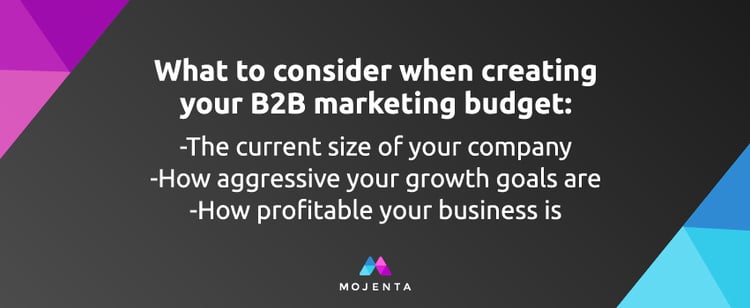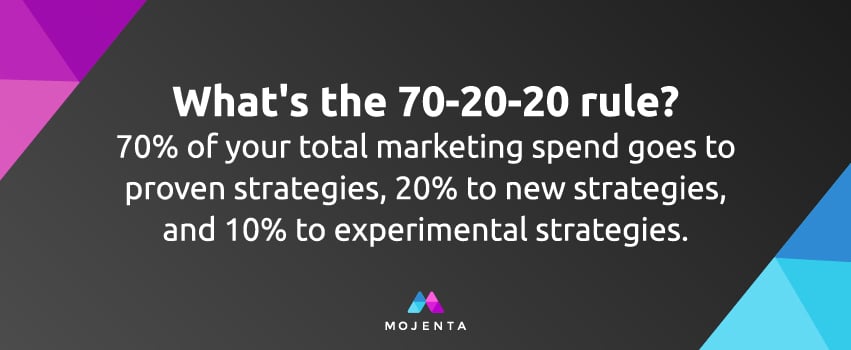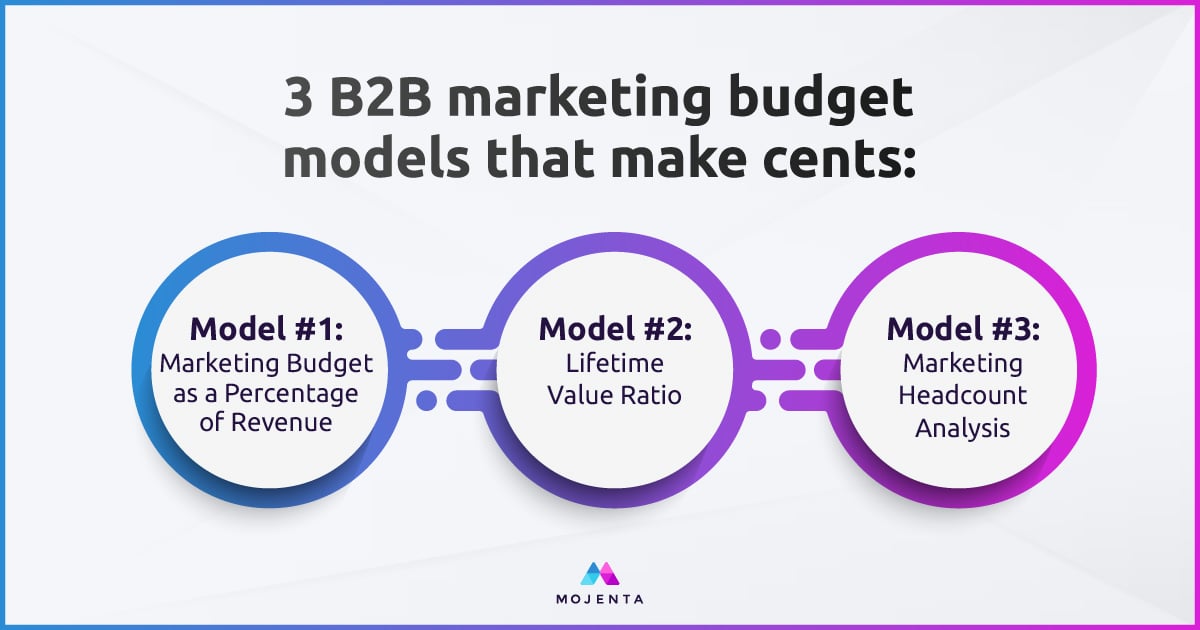Many B2B telecom, IT, and cloud companies ask us what they should be spending on marketing. It’s an excellent question, and one that isn't always easy to answer – especially if you’ve never had a formal B2B marketing budget before.
To help you come up with the right numbers, here are three B2B marketing budget models to consider:
Model #1: Marketing Budget as a Percentage of Revenue
This marketing budget model is the easiest to calculate and the most commonly referenced among marketing leaders. You simply apply a percentage of your total company revenue to your marketing spend, typically 6-20%.

What should your percentage be? It depends on:
- The current size of your company
- How aggressive your growth goals are
- How profitable your business is
Here are a few takes on the revenue percentage model:
Small Business Marketing Budgets
According to the Small Business Association, companies under $5M in annual revenue typically spend 7-8% of their top line on marketing.[1]
"As a general rule, small businesses with a total revenue of less than $5 million should allocate 7-8 percent of their revenues to marketing. This budget should be split between
1) brand development costs (which includes all the channels you use to promote your brand, such as your website, blogs, sales collateral, etc.), and
2) the costs of promoting your business (campaigns, advertising, events, etc.)."
B2B Services Marketing Budgets
Looking at B2B specifically (which includes telecom, IT, and cloud), Deloitte published in its 2020 CMO Survey that B2B services companies are spending 11.4% of revenue on marketing.[2]
On the flip side, according to Gartner's 2021 CMO Spend Survey, IT services businesses are currently spending 5.9% on marketing, down from 9.6% in 2020.[3]
Consider what some of these large, publicly traded companies spend on their marketing budgets, according to Vital:[4]
- SalesForce: 46%
- Tableau: 51%
- Microsoft: 15%
- Google/Alphabet: 11.9%
- Oracle: 22%
You've Gotta Start Somewhere
We know that going from zero to 20% (or even 6%) can be a big jump, so first, get clear on your past and projected total revenue. Then decide as a leadership team where you can start and how you can expand.
IMPORTANT! Many companies make the mistake of investing too little at the beginning of a new marketing strategy. They say, "I'll invest this little bit, and when it pays off, I'll invest more."
Seems logical, but many times that money is wasted. Remember, many airplanes burn more than half of their fuel on takeoff and climb. Business is no different. It takes significant effort to get off the ground, but once airborne, you can cruise for a very long time. If you put too little into your marketing spending upfront, you won't have enough power to get any lift.
Also consider that in a competitive industry, many companies are spending big. Make sure you invest enough to make an impact.
Model #2: Lifetime Value Ratio
Another marketing budget model to consider is your lifetime value (LTV) to cost of acquisition (COA) ratio. According to Corl, you should target a 3:1 or 4:1 ratio for optimum growth.[5] Spending more than that means your margins will be thin or nonexistent; spending less means you’re probably not reaching your growth potential.
How to Calculate Lifetime Value (LTV)
To calculate your LTV, multiply your average monthly revenue per customer by the customer lifetime in months.
For example, if your average monthly recurring contract is $2500, and your average contract length is 36 months, your lifetime value is $90,000.
$2500 X 36 = $90,000

How to Calculate Cost of Acquisition (COA)
To calculate COA, take your total sales and marketing expenses, and divide that value by your new customers acquired.

Your Ideal LTV:COA Ratio
Below are some industry benchmarks on what your ideal ratio would be, using the $2500 MRR at 36 months example from above.
- 1:1 You will lose money the more you sell - $90,000
- 3:1 Good ratio (industry benchmark) - $30,000
- 4:1 Indicates a good business model - $22,500
- 5:1 Likely under-investing in marketing - $18,000
In this example, your ideal COA would be between $22,500-30,000 (total sales and marketing expenses).
This marketing budget model works best for companies that are past the startup phase, have access to these data points, and have an in-house sales team.
For an even more detailed version of this LTC:COA model (including churn), check out this post by geckoboard.
Model #3: Marketing Headcount Analysis
The final way you can think about your marketing budget is in terms of marketing headcount.
Before we get into these numbers, let's think for a moment about all the skill sets necessary to run a holistic marketing program. According to CoSchedule, there are 50 essential skills to be successful in marketing.[6] Fifty!!! Here are some of our favorites:
Marketing Skill Sets
- Marketing strategy & budgeting
- Branding, messaging, positioning
- Storytelling & persuasion
- Copywriting & proofreading
- Design
- Web and email development
- Digital marketing strategies
- MarTech strategy and management
- Ads management
- Reporting and analytics
This is by no means a comprehensive list but should convey that no single person can possibly have all these skill sets (and if they did, no one could afford them!).
So if you hire an internal marketing person (which most companies should), they will still need a marketing budget to outsource some of the essential activities you'll need to be successful.
For these calculations, you'll need to do some research on marketing salaries in your local area.
Marketing Titles & Median Salaries
Here's what some median marketing salaries look like for Chicago, IL, according to Salary.com:
- Marketing Director: $157,221
- Digital Marketing Manager: $115,193
- Graphic Designer: $60,000
- Web Developer: $121,390
- Brand Strategist: $63,771
- Copywriter: $70,928
To hire this whole team in-house would cost you around $600,000 per year just in salaries – and closer to $900,000 with taxes and benefits factored in.

Another approach is to hire a smaller in-house team of one or two people and outsource the rest either to contractors or marketing agencies that can fill the gaps in your current team's skill sets.
Typically for the price of one or two marketing headcount, you can access an entire team of expert marketers without the costs associated with hiring, training, and maintaining employees.
Other Considerations When Setting Your B2B Marketing Budget
If you haven't spent much on marketing in the past or you're at the start of your budgeting journey, here are a few considerations to help hone in on the right model to use for your business:
Market Landscape
Are you in a crowded market with high competition, or a relatively untapped market? Higher competition typically means you'll need a bigger marketing budget to stand out, whereas a niche market may allow for a more limited marketing budget.
Business Goals
Marketing isn't isolated – it should be closely tied to your overall business objectives. Do you want to build more brand awareness, generate qualified leads, or expand into new markets? All of the above? Different goals will require different marketing strategies and resource allocations, so make sure your marketing spend aligns with your overall goals to create a more cohesive strategy.
Sales Cycle Length
Knowing the length of your sales cycle can help you get a better picture of what to focus on. A shorter sales cycle may mean having to invest more in customer acquisition to hit your marketing goals. But if you're running a B2B SaaS company where customers tend to have longer consideration cycles, then you'll likely focus your marketing spend on lead nurturing instead.
ROI Expectations
Setting realistic expectations and benchmarks can help you make sure your marketing investments are producing tangible results. By knowing when to double down or change course, you'll get more value from your marketing dollars and reach your growth goals faster.
Making the Most of Your Marketing Budget (Once You’ve Decided on a Model)
After you've established your marketing budget using one of the models we outlined above, prioritize making the most out of every dollar you spend. Here are some tips to help you optimize your marketing budget:
Know Your Customers
The B2B customer journey is full of twists and turns. Taking time to understand your audience can help you uncover important information – like which messages resonate with your audience and what solutions will convert them – to optimize your marketing activities.
Explore Different Channels
B2B marketing encompasses a wide range of channels, from digital to offline channels and everything in between. Consider the channels that resonate most with your audience and align with your goals. Digital marketing channels might include content marketing, social advertising, and email marketing, while offline options could involve traditional advertising and attending trade shows. Allocate your marketing budget based on the channels that offer the most potential for engaging your target audience.
Prioritize High-ROI Activities
Not all marketing activities are created equal. Focus your resources on channels and strategies that have proven to provide a high return on investment. If you have data suggesting some underperforming marketing channels might still be worth investing in, consider using them for experimentation and apply the 70-20-10 rule when budgeting for them. Here, you'll put 70% of your total marketing spend toward proven strategies, 20% toward new strategies, and 10% toward experimental strategies.

Repurpose and Update Your Content
Creating unique content can be expensive. If you have evergreen content that still brings value to your audience, such as a research report or white paper, taking the time to repurpose and update it may help it move up the SERPS and maximize value from your marketing efforts.
Automate Where Possible
Marketing automation technology can help you cut down on manual labor costs and free up your marketing team to focus on tasks that require a human touch, saving you time and money in the long run.
Invest in Your Team
No marketing budget is complete without an investment in your team's professional development. Whether it be training, certifications, events, or seminars, investing in the growth of your team can result in improved performance and better ROI on your initiatives, including your marketing efforts, over time.
Consistently Re-Evaluate Your Marketing Strategy
By performing a biweekly or monthly review of your budget allocation, you can potentially cut unnecessary spending, reallocate to high-performing marketing campaigns, and decide when to adjust costs like digital ad spending.
A Marketing Budget That Works FOR You
Creating a marketing budget is no easy task, so we hope these models are helpful and get you pointed in the right direction.
Of course, more important than the number itself is that the budget you invest drives the results you desire. If you'd like to chat with us further about your marketing goals or need help calculating your ideal marketing budget, feel free to schedule time with us here.
Sources:
- https://www.sba.gov/taxonomy/term/15051?page=37
- https://www2.deloitte.com/us/en/pages/chief-marketing-officer/articles/cmo-survey.html
- https://www.gartner.com/en/marketing/research/annual-cmo-spend-survey-research
- https://vtldesign.com/digital-marketing/content-marketing-strategy/percent-of-revenue-spent-on-marketing-sales/
- https://medium.com/corl/how-to-calculate-lifetime-value-customer-acquisition-cost-ratio-for-your-saas-business-332510188726
- https://coschedule.com/blog/marketing-skills



